| Lista Light |  |
Bay of Biscay
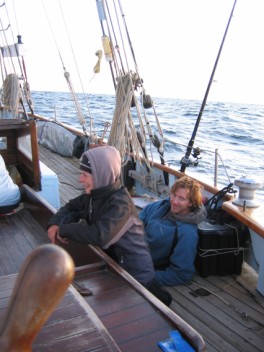
Apart from a lack of wind, the days slip pass, reading, watching and spotting birds. The Blasket Island cliffs passing us by are spectacular formations of rock with billowing clouds snaking around them. Abandoned cottages prick the hills sides, often with modern buildings perched by the side of them. The hillsides show remnants of former enclosure systems through gradations in the colour of the vegetation and crumbled walls. Gannets full the sky in a feeding frenzy skewing a fish ball beneath them. We receive warnings via the ‘Burnyeataafon’ that storms are imminent and retreat to Dingle.
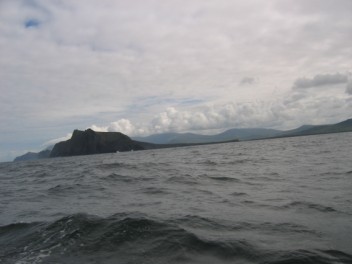
We sail into the fishing harbour and see Dan our new crew member waving from the wall. We moor amidst a jumble of living and wrecked fishing boats to which Lista easily merges into. We peer into the fishing boats: camping stoves, cigarettes, coffee, crisp packets and a few magazines are strewn around the galley. Paint peels from the walls, water sloshes on the floor and anchor winches rust. It’s a bleak, Spartan existence, I don’t envy their lives on the high seas; cold, wet, nauseous, constant motion, pulling in nets of fish, plunging freezing hands into the mass of flapping bodies to sort them.. and this is only in my imagination, I expect the reality is far worse.
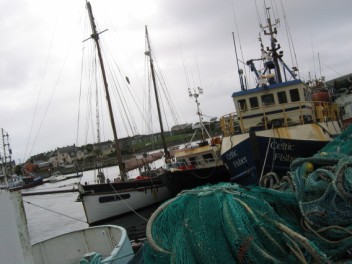
We jump through nets and scramble along metal decks, over the line of boats that we are moored against and finally climb onto the pier. It’s 9.00pm and we’re walking through what feels like a film set. A huge Spanish trawler dwarfs the pier and a crumbling building. Dark faces peer and leer at us as we skulk passed. My skin crawls, it feels as if they haven’t seem female flesh in months. A reporter holds a microphone under a fisherman’s nose, it feels as if we’ve stumbled across a seedy underworld.
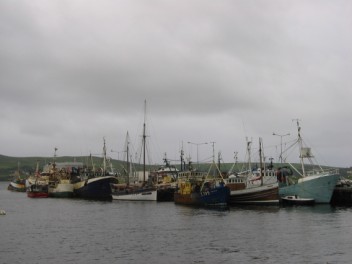
In the morning we are given a net of crab crawls. We snaffle them with fresh bread, salad and lashings of Mary Rose sauce dribbling over our chins and hands. Delicious! We remain in Dingle for a couple of days sitting out the storm. Dave and I run up the nearest hill, we follow a track pock marked with horses’ hooves and flanked by sheep. A team of choughs rises from our feet, squawking. Rocks splatter the hillside like unruly teeth, but the ridge we can see from the base is a sequence of false horizons and we never really make it to the top. We can see the sea and the distant hills, our last view before the rain curtain sets in. So we plunge back down the slope, flying off the boulders and jumping through the air.
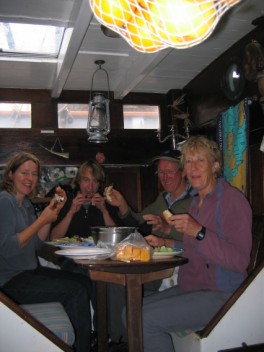
All day, a group of Philippino fishermen mend nets on the pier in the pouring rain with plastic gloves on their hands, wearing yellow overalls. Dan and Clare explore Dingle and learn of the infamous Fungy, the apparently twenty-five year old bottle nosed dolphin who swims in the bay. We are slightly worried about what will happen if Fungy ‘carks it’, it seems the town’s tourist trade is based on the celebrity dolphin. We have doubts, with visions of locals dressing up as dolphins and swimming around the harbour to keep the folk lore alive.
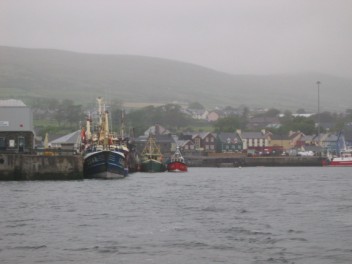
I chat to a fisherman and he assures me that Fungy is real. He also tells a melancholy tale of the fishing port at Dingle. Less than thirty years ago he remembers over twenty, small, local fishing boats based in the harbour, a cornerstone industry of the town. Now the tale is very different, one of huge trawlers, dominated by foreigners, collapsed fishing stocks and limits on fish sizes. Fishermen are bitter and sour. My fisherman describes how he will have to pay over £20 000 to meet EU standards and keep his boat working, but he doesn’t have the funds.
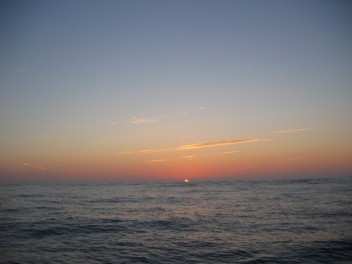
What is the answer? The stark facts are that fish stocks have collapsed in many of the world’s oceans. Fishermen routinely throw back thousands of undersized dead fish into the sea each year that will never replenish stocks. The methods for harvesting fish have become increasingly mechanised, using radar and satellite imagery boats can target fish rapidly efficiently. There is little hope for fish stocks if man continues at this rate. North Sea cod stocks have collapsed, eels and salmon are at risk, just about any fish you can think of is threatened. It’s a liturgy of woes and the fishermen feel the brunt of it, but this tragedy of the commons cannot continue. If there are no fish, then there will be no fishermen. A hundred years ago no one would have believed that mankind would be able to decimate the plenty of the oceans, but then could they have believed that we could destroy great tracks of rainforest the size of Wales each day or plough up mile upon mile of pristine Russian steppe.........?
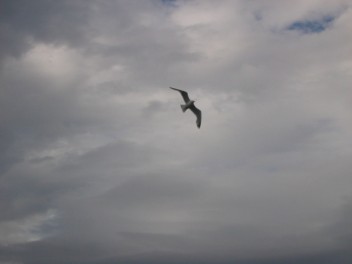
On this dark note we leave Dingle. The winds are still high, but we had to leave if we are to reach North Spain by the beginning of September. We forge out of the harbour and who should accompany us but Fungy himself!! The huge bulk of Fungy leaps from the waves at our side and rubs against Lista’s bow, our parting siren.
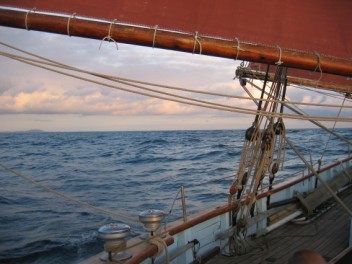
The waves boil, the sky turns leaden and we lurch and nose-dive into the howling sea. Dan turns green and I shortly follow him, before long and a couple of ‘voms’ later we are out for the count. Dan has a particular miserable bout of sea sickness and is laid low for some time. I manage to creep out on deck the next day and grow accustomed to the pitching which gradually starts to ease. Dan emerges later and is soon back to his high spirited, puppyish ways.
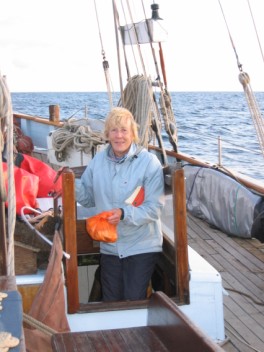
As we plunge into the waves, the engine stops working. Now, we have resolved to use Lista’s engine as little as possible, preferably only as a safety mechanism. The problem is that we need to speed to Spain in order to reach our ferry home to Dave’s cousins wedding and my sister’s wedding. The other issue is the Bay of Biscay, when I ask Brian and Anne (who have circumnavigated the world) what their worst crossing was, without hesitation they say the Bay of Biscay.
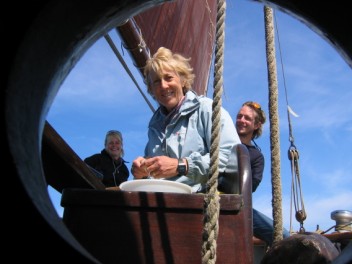
The Bay of Biscay is legendry for its fiery oceans. This is on account of the huge Atlantic fetch coupled with the underwater topography which allows waves to grow before crashing onto the shallow shelf. The sooner we sail this hazardous stretch of water the safer and we decided that if that required some motoring then so be it. After this stretch, however, we are committed not to use it, only to be powered by the wind, even if we drift for days without a gust.
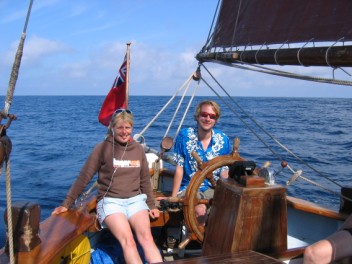
Back to the engine failure. At this particular moment safety is high on the agenda. The wind is pulling us towards a group of jagged island cliffs, the Bull, Cow and Calf at the base of Ireland. We cannot manoeuvre away from them and we have no mechanical back up. We fly as much canvas as possible and Dave plunges into the engine room to deal with the corpse. Clare pops out with an old drive belt in her hand asking for a spare! While Dave’s natural instinct is to sail Lista out of trouble, Clare the motor boat gal, heads straight for the engine room. She has sorted the problem and we realize (if we hadn’t before) that we have an ally on board!
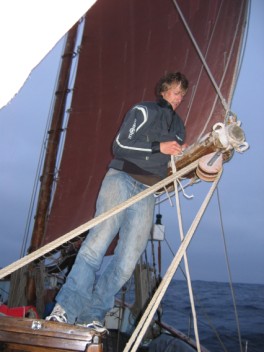
The weather improves, with a couple of days and nights of really strong winds, allowing us to maintain average speeds of 7 knots/hour. We slosh through the waves and take it in turns to keep watch for boats. I find the motion handicaps activity, as I am incapable of working below deck when we list from side to side and nausea sweeps over me.
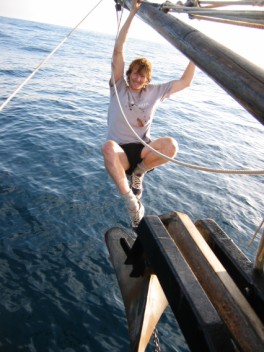
We scan the waves for life. The normal suspects follow us, fulmars, gannets and then a Mediterranean shearwater and tiny storm petrels, like sparrows over the waves. Then one scorching day, as we pier over Lista’s bulwarks we spot jelly fish. These are not the normal jellyfish, of umbrella shapes with streaming tentacles. These are quite extraordinary singular cases of jelly attached to one another. It looks like a lady has dropped her bag of curlers over board and the rollers are spongy and linking together to form vast coils of rope. The weird, translucent, hoards of jellyfish drift passed us for miles. I still haven’t traced the origin of this phenomenon but will let you know if I find out.
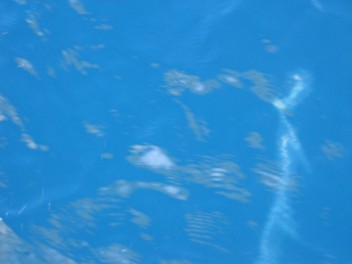
The next ghostly image is dead fish. Layer upon layer of small white fish drift passed us. There must be thousands on their backs. The only likely explanation appears to be by-catch, that the fish were jettisoned for not meeting the required market size. We shall continue to search for likely explanations.
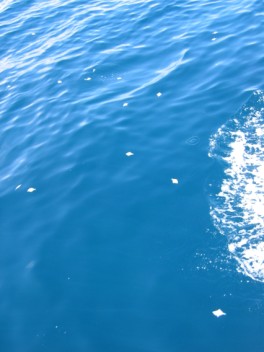
Dave is sitting on deck thinking. The Bay of Biscay is famous for sightings of whales, particularly in late Summer when high pressure systems settle allowing calm conditions for finding whales. By late Summer water temperatures are also higher, allowing phytoplankton to flourish. These free-floating marine plants form the base of much of the marine ecosystem, fuelling directly or indirectly microscopic organisms and mighty whales. Phytoplankton is in abundant in the Bay of Biscay due to the sudden drop in gradient over the continental shelf. Cold ocean currents rich in nutrients are forced up from the ocean floor miles below to meet the shallow shelf, bringing with them a wealth of phytoplankton. This abundance attracts fish, crustaceans and squid, as well as cetaceans.
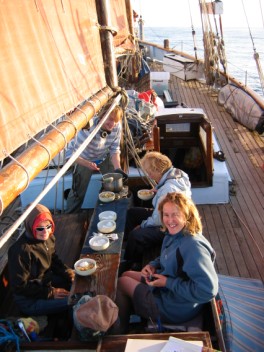
Dave is thinking about those whales and why we haven’t seen any and that wildlife watching is generally like this, when you look for something you don’t see it. One could become apathetic and lose interest, but that is the very mystery and intrigue in nature, if it presented itself on a plate to us, there would be no surprise.
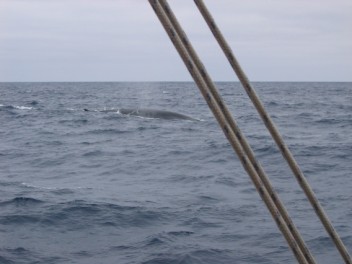
Then out pops a whale!! Can you believe it! He screams from the deck and we all scramble to catch a glimpse. Two huge grey forms undulate through the surf. We see their heads, backs, fins and giant jets of water flush into the sky. They are colossal, bigger than Lista’s 16 odd metre length. We are humbled and dwarfed by their bulk. All six of us clamber as high as we can to drink in the sight. I have never seen anything as spectacular in my life. They swim close to suss Lista’s bulk out, could she be a rival or a possible mate?! I want to dive in and clamber on their backs, but they soon recede into the distance until even their ‘blows’ are no longer visible.
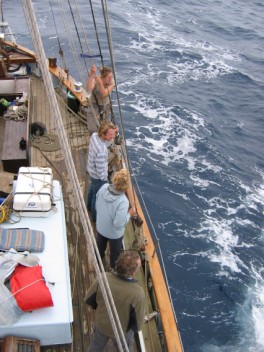
We crowd around the book to work out what species we have witnessed and finally conclude they were fin whales. Fin whales can grow up to 26m and typically feed on fish, prawns and squid. They are widely distributed around the world, moving to warmer latitudes in the winter to mate and calve. The Bay of Biscay is an important Summer feeding ground for the species, which is the most abundant baleen whale in the area.
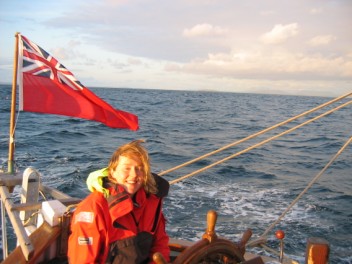
There are two types of whales, baleen and toothed whales. Baleen whales have plates of baleen or whalebone, which hang from the roof of their mouths. These vertical plates can grow up to 2m long in species such as the blue whale and are used to filter enormous quantities of crustacean and small fish. There are nearly seventy species of toothed whales, which include dolphins and porpoises.
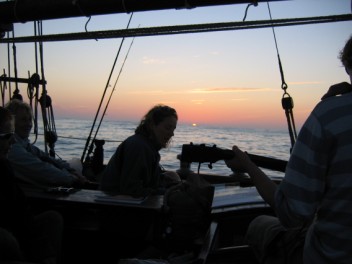
As we near the North West of Spain the night brings tankers and ferries crashing upon us from all directions through the shipping lanes that we must cross. Their lights so simple to decipher in the book become a blur of colours as I try and decide which way they are heading. Then lightening streaks through the sky and for hour upon hour it feels as if we are floating on a battle field as the horizon and distant ships are lit up by forks of lightening.
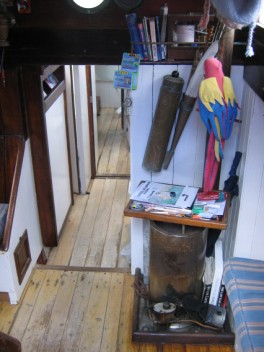
A pigeon circles our boat and attempts to land, but each time is thrown off course by Lista’s boom. Finally she settles and shattered she side steps to a crevice on top of the cabin. We feed her water and wheat, at least she is can rest her weary wings, even if she is still being battered by the storm. By the morning she is looking decidedly perky and we perch in the galley near food and water. She preens and gains a spring in her step, vociferously pooing all over the seat before waddling down to Dan’s bunk to coo in his ear. We decide she has had enough of luxury and bring her back to reality on deck where she hops around, avoiding Dave’s grappling hands.
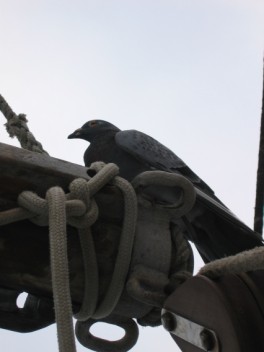
Snatch 2’, as she is christened, after the last racing pigeon that flew into out-stretched arms before making a dash for freedom, remains with us for a full two days and a half. During that time another vagrant appears on a deck and really a far more beguiling passenger in the form of a tiny warbler. Well, that is the genus I think it must be, but I cannot locate it in the text book and can only presume that it is rare vagrant blown of course on the Easterly winds. I have footage of the passerine and hope to identify it soon, will help form a clutch of ‘twitchers’
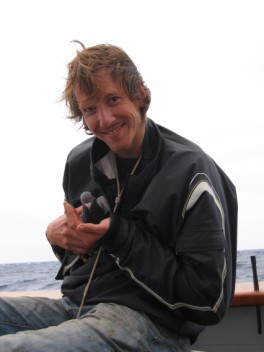
Our pretty warbler departed rapidly, luckily after a good refueling. Snatch the second, is less decorous and after guzzling his way through our rashons, leaving her calling card all over the decks and far out staying her welcome, flies off at the first sniff of land. ‘Sniff’ it certainly the word, after five days at sea, we smell land before seeing it. The stench of humanity wafts through our nostrils. I can sense how the character in Peter Suskind's ‘Parfume’ feels as he avoids settlements and their wretched human odours at all costs. A mix of sewage and salt, followed by sky scrapers and concrete greets us.
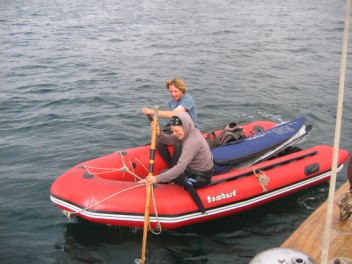
How ever the port might smell, I am still very pleased to see it. We anchor in A Coruna in the rain. Over the next couple of days, Dave and I hardly leave the Lista as we mend, tap and tidy. We do manage to cycle off to Sada to see if we can find accommodation for Lista during our absence. This involves cycling some 15 km away along dual carriageways and flyovers and then through suburbs. It seems the Spaniards do not commute on bikes, generally viewing the ‘bicicleta’ as a tool for leisure rather than business, consequently the roads are fairly hostile, but drivers generally give us a wide berth.
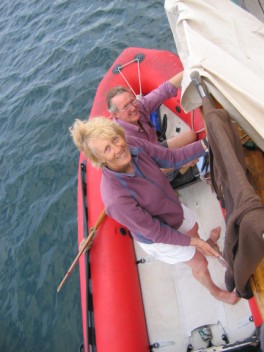
It’s great to leave the city and see orchards full of apples and peaches. This North Western corner of Spain is remarkably similar to England. It is verdant with familiar species such as brambles, stinging nettles and blackbirds, but then you are stopped in your tracks by a lizard or the sound of the cicadas and you realize it is anything but England.
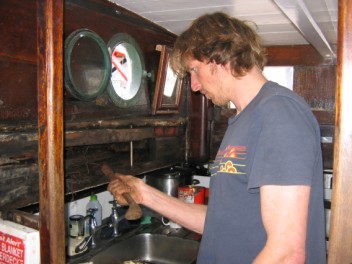
The buildings are also very different, modern and bright with terracotta roofs. Occasionally, old buildings have been saved and are often accompanied by a small out house on stilts used for drying maize. We do not have time to explore further afield, hopefully one day...
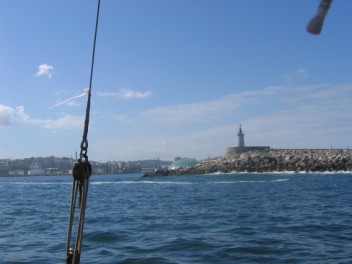
Clare and Dan have meanwhile been walking in ever decreasing circles around La Coruna, relishing getting lost and arguing! They have sample a good few watering holes and Clare determined not to utter a word of the local lingo, is adamant that she can get by on her faithful hand signals, drawings and miming... Which of course she does and makes a good few friends along the way for good measure. Dan is mastering the fineries of ‘Cerveza’ speak and together they sample the local brews and fiery concoctions, intermingled with some light surfing.
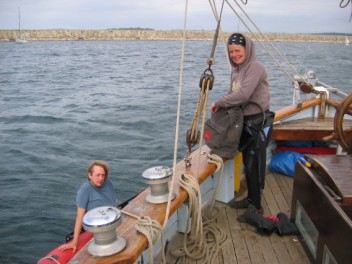
On September 3, we leave Lista, Clare, Dan and La Coruna. Miraculously we completed the Bay of Biscay without trauma. Anne and Brian were able to catch their plane home after leaving us with a wealth of knowledge and charts and we should catch our ferry!
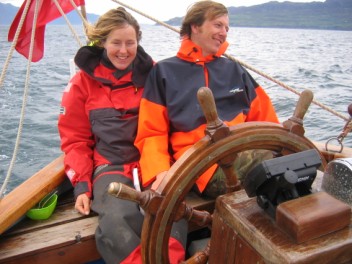
Back to previous section - West Coast of Scotland
Forward to next section - A Caruna (Spain) to Oporto (Portugal)
This page hit Count : 6253
This is the Lista Light Website, for the travels of the sailing boat Lista Light
Click here for text-version of site